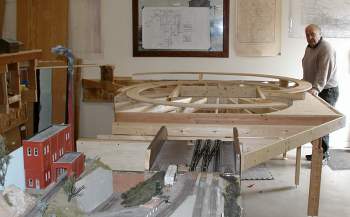
|
A main line
high bridge over a pair of tracks and a creek below.
Or solving a scenery dilema between Derby and Butte Falls.
|

|
The pass at Summit,
the high point of the Pacific & Eastern in the Cascade Mountains.
|

|
The Medford Corporation in
1989 modeled in a tiny fraction of the space of the original. How
it might have looked had the P&E survived.
|
|
|

|
2008 brings a major change
to the Pacific & Eastern Railroad. The decision was made to
get started on the Klamath Falls "leg" with a one and a third turn
helix connecting, temporarily, to the Mt. Pitt and Medford Yard
Modules. For a while, Mt. Pitt will become Keno and the Medford Yard
stand in for the P&E's Klamath Falls yard. This will enable
the club to resume operating sessions as well as providing more
prototypical train operations on Sunday Run Days. It will also
mean the end of the loop of modules which had held court on the south
side of the clubhouse for the past five years. Join us as we
build the helix and connecting trackwork.
|
|
|
|
|
|
|
|
|
|
|
|
|